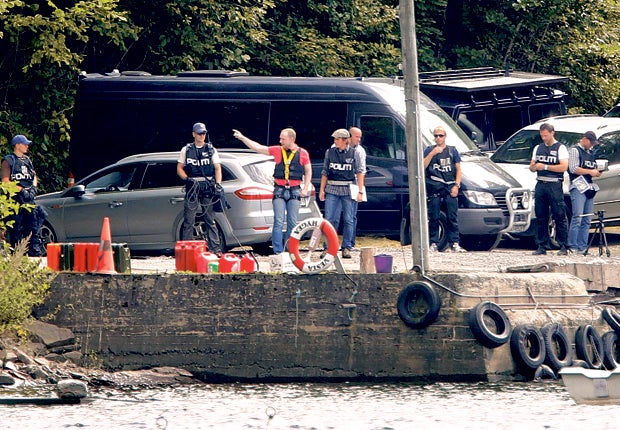Breivik is taken back to scene of the crime to show police how he did it

Norway's self-confessed mass murderer, Anders Breivik, has been taken back to the island where he slaughtered 69 young people, to show investigators exactly how he did it.
Police said yesterday that the 32-year-old gunman was driven to the scene of his crime on Norway's Utoya island, north-west of Oslo, on Saturday, where he spent eight hours reconstructing the shooting he carried out only hours after killing eight people in a bomb attack in the capital.
"The suspect wasn't emotionally unaffected by being back on Utoya, but he did not show any remorse," said Paal-Fredik Hjort Kraby, who is prosecuting the case.
Eerie photographs of Breivik's return to Utoya were published in Verdens Gang newspaper yesterday. They showed the killer wearing a bulletproof vest and tied to a lead held by a police officer as helicopters hovered overhead. Breivik was said to have taken the same ferry to the island that he used on the day of the massacre.
One of the photographs showed him standing and pretending to aim a rifle towards the fjord waters surrounding Utoya, where he shot and killed several of his panic-stricken victims as they tried to swim away from the island.
Mr Hjort Kraby said Breivik was "calm, detailed and collaborative", as he walked the same route he took on the day of the massacre and explained exactly what had happened.
The killer was filmed as he described the events of the massacre and the footage is expected to be used as evidence at his trial next year.
Geir Lippestad, Breivik's lawyer, said yesterday that his client had been able to recall in detail each shot he fired and every person he had killed on the afternoon of 22 July, with the assortment of high-powered rifles and automatic weapons he had taken to the island.
Police confirmed yesterday that Breivik had called them several times himself during the attacks, in what appeared to be an attempt to give himself up.
Mr Lippestad has said that his client is probably insane. However, police psychiatrists say that Breivik appeared to be fully in control and aware of his actions during both attacks and that the courts would be unlikely to accept a plea of insanity.
If convicted, Breivik would face a maximum 21 years imprisonment. However, under Norwegian law, he could remain in custody indefinitely after serving his sentence, if still considered a danger to the public.
Join our commenting forum
Join thought-provoking conversations, follow other Independent readers and see their replies
Comments
Bookmark popover
Removed from bookmarks